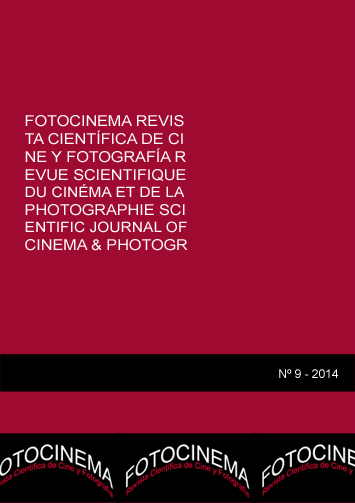¡No lo haré más!: la sociedad española en El verdugo de Berlanga
DOI:
https://doi.org/10.24310/Fotocinema.2014.v0i9.5965Abstract
Recientemente, la influencia del director Luis García Berlanga ha sido destacada por crítica y público. Generalmente asociado por su colaboración con el guionista Rafael Azcona, Berlanga fue un cineasta atípico cuyas películas han sido irónicas, pero serios exponentes de la evolución de la sociedad española durante el pasado siglo.En el presente artículo, intentaremos mostrar uno de sus más importantes trabajos, El Verdugo, analizando no solamente sus aspectos sociales, sino incluyendo un estudio del lenguaje cinematográfico empleado para ello y el particular estilo con el que el director abordó algunos de los temas más controvertidos de su tiempo.
Abstract:
The influential of the director Luis García Berlanga has been recently increased by critics and public. Generally associated with the script-player Rafael Azcona, Berlanga was an unusual artist which films have been and ironical but serious example of the changes and the evolution of the Spanish society during the last century.
In the present article, we will try to show the social aspects of one of his most important masterpieces, El verdugo, analyzing not only the historical context, but also including his cinematographically language and particular style for translate to the big screen some controversial realities of their time.
Palabras clave:Berlanga; Azcona; contexto social; ironía; El Verdugo.
Keywords:
Berlanga; Azona; Social Context; Irony; El Verdugo.Downloads
Metrics
Publication Facts
Reviewer profiles N/A
Author statements
Indexed in
-
—
- Academic society
- N/A
- Publisher
- Universidad de Málaga
Downloads
Published
How to Cite
Issue
Section
License
All contents published in Fotocinema Revista científica de cine y fotografía are protected under the Creative Commons Attribution-NonCommercial-ShareAlike 4.0 International (CC BY-NC-SA 4.0) license. All about this license is available in the following link: <http://creativecommons.org/licenses/by-nc-sa/4.0>
Users can copy, use, redistribute, share and exhibit publicly as long as:
- The original source and authorship of the material are cited (Journal, Publisher and URL of the work).
- It is not used for comercial purposes.
- The existence of the license and its especifications are mentioned.
There are two sets of authors’ rights: moral and property rights. Moral rights are perpetual prerogatives, unrenounceable, not-transferable, unalienable, imprescriptible and inembargable. According to authors’ rights legislation, Fotocinema. Revista científica de cine y fotografía recognizes and respects authors moral rights, as well as the ownership of property rights, which will be transferred to University of Malaga in open access. The property rights are referred to the benefits that are gained by the use or the dissemination of works. Fotocinema. Revista científica de cine y fotografía is published in an open access form and it is exclusively licenced by any means for doing or authorising distribution, dissemination, reproduction, , adaptation, translation or arrangement of works.
Authors are responsable for obtaining the necessary permission to use copyrighted images.














13.png)



